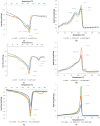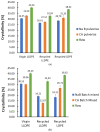An Analysis of Foams Produced from Recycled Polyolefins and Low-Cost Foaming Agents: Benchmarking Using Pore Size, Distribution, Shear Effects, and Thermal Properties
- PMID: 40363054
- PMCID: PMC12074132
- DOI: 10.3390/polym17091270
An Analysis of Foams Produced from Recycled Polyolefins and Low-Cost Foaming Agents: Benchmarking Using Pore Size, Distribution, Shear Effects, and Thermal Properties
Abstract
Foamed specimens were fabricated from virgin and recycled polyethylenes (linear low-density polyethylene, LLDPE, and low-density polyethylene, LDPE) using low-cost citric acid and sodium bicarbonate foaming agents. The foaming agents chosen showed decomposition behaviour either without phase change (sodium bicarbonate, NaB) or liquefaction followed by decomposition (citric acid, CA). The manufactured polyethylene foams were then benchmarked against a polyurethane foam. Two types of mixing were used prior to foaming, viz., solid-state pulverisation or high-shear internal mixing, and the effect of mixing on properties critical for foam viability were analysed. These properties included density, pore size, shape and distribution, crystallinity, and porosity. It was found that the virgin LLDPE and recycled LDPE showed similar trends in terms of narrow pore size distribution and reduced crystallinity, while the recycled LLDPE tended towards more pore coalescence. This difference in behaviour was attributed to the more mixed phase nature of the recycled LLDPE as opposed to the majorly single-phase virgin LLDPE and recycled LDPE. Lowered densities obtained for the NaB foaming compared to CA can be speculated to be because of the ionic and simple NaB decomposition as opposed to the complex radical pathway for the CA decomposition.
Keywords: density; foaming; pore size distribution; recycled polyolefins; shear.
Conflict of interest statement
Author John Stehle was employed by the company Robovoid Pty Ltd. The remaining authors declare that the research was conducted in the absence of any commercial or financial relationships that could be construed as a potential conflict of interest.
Figures
















Similar articles
-
Microstructural Contributions of Different Polyolefins to the Deformation Mechanisms of Their Binary Blends.Polymers (Basel). 2020 May 20;12(5):1171. doi: 10.3390/polym12051171. Polymers (Basel). 2020. PMID: 32443687 Free PMC article.
-
Recycling of low-value packaging films in bitumen blends: A grey-based multi criteria decision making approach considering a set of laboratory performance and environmental impact indicators.Sci Total Environ. 2021 Jul 15;778:146187. doi: 10.1016/j.scitotenv.2021.146187. Epub 2021 Mar 8. Sci Total Environ. 2021. PMID: 33714093
-
Foamed Phase Change Materials Based on Recycled Polyethylene/Paraffin Wax Blends.Polymers (Basel). 2021 Jun 17;13(12):1987. doi: 10.3390/polym13121987. Polymers (Basel). 2021. PMID: 34204406 Free PMC article.
-
Fabrication, Processing, Properties, and Applications of Closed-Cell Aluminum Foams: A Review.Materials (Basel). 2024 Jan 24;17(3):560. doi: 10.3390/ma17030560. Materials (Basel). 2024. PMID: 38591408 Free PMC article. Review.
-
Forefront Research of Foaming Strategies on Biodegradable Polymers and Their Composites by Thermal or Melt-Based Processing Technologies: Advances and Perspectives.Polymers (Basel). 2024 May 3;16(9):1286. doi: 10.3390/polym16091286. Polymers (Basel). 2024. PMID: 38732755 Free PMC article. Review.
References
-
- Lee S.T., Park C.B. Rheology of Thermoplastic Foam Extrusion Process. CRC Press; Boca Raton, FL, USA: 2014. pp. 56–99.
-
- Liu S., Huang Q., Chen Q., Huang X.B. Application of Extensional Rheology in Polymer Characterization. Acta Polym. Sin. 2023;54:286–302. doi: 10.11777/j.issn1000-3304.2022.22245. - DOI
-
- Parky C.P., Garcia G.A. Development of Polypropylene Plank Foam Products. J. Cell. Plast. 2002;38:219–228. doi: 10.1177/0021955X02038003268. - DOI
-
- Jiang Q.X., Bismarck A. A perspective: Is viscosity the key to open the next door for foam templating? React. Funct. Polym. 2021;162:104877. doi: 10.1016/j.reactfunctpolym.2021.104877. - DOI
Grants and funding
LinkOut - more resources
Full Text Sources
Medical

